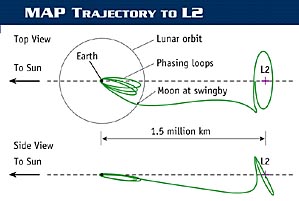
WMAP Mission Overview
The Wilkinson Microwave Anisotropy Probe (WMAP) mission reveals conditions as they existed in the early universe by measuring the properties of the cosmic microwave background radiation over the full sky.
This microwave radiation was released approximately 375,000 years after the birth of the universe. WMAP creates a picture of the microwave radiation using differences in temperature measured from opposite directions (anisotropy).
The content of this image tells us much about the fundamental structure of the universe.
Mission
The WMAP mission was proposed to NASA in 1995, launched in 2001, and operations were completed in 2010.
The Spacecraft was launched June 30, 2001 on a Med-Lite Delta II 7425-10 vehicle into a lunar assisted trajectory to the Sun-Earth L2 libration point for a nominal 27 month mission (3 months transit to L2, 24 months observing). The mission was subsequently extended to collect additional flight data. The total payload mass is ~830 kg. The WMAP instrument is continuously shaded from the Sun, Earth, and Moon by the spacecraft to allow lower thermal disturbances. WMAP ended the collection of science data on August 19th 2010.
Observatory
The WMAP instrument consists of a set of passively cooled microwave radiometers (connected to radiator panels with metal straps) with 1.4 x 1.6 meter diameter primary reflectors to provide the desired angular resolution. Measuring the temperature of the microwave sky to an accuracy of one millionth of a degree requires careful attention to possible sources of systematic errors. The avoidance of systematic measurement errors drove the design of WMAP:
- The instrument has five frequency bands from 22 to 90 GHz to facilitate separation of galactic foreground signals from the cosmic background radiation.
- WMAP is a differential experiment: if you would like to know whether one piece of wood is longer than another, it is better to put the pieces directly next to each other than to measure them separately with a ruler. WMAP measures the temperature difference between two points in the sky rather than measuring absolute temperatures.
- An orbit about the Sun-Earth L2 libration point that provides for a very stable thermal environment and near 100% observing efficiency since the Sun, Earth, and Moon are always behind the instrument's field of view.
- A scan strategy that rapidly covers the sky and allows for a comparison of many sky pixels on many time scales.
View a live 3D model of the Observatory!
Science
To address its key scientific questions, WMAP measures small variations in the temperature of the cosmic microwave background radiation. These variations are minute: one part of the sky has a temperature of 2.7251° Kelvin (degrees above absolute zero), while another part of the sky has a temperature of 2.7249° Kelvin. In 1992, NASA's Cosmic Background Explorer (COBE) satellite detected these tiny temperature differences on large angular scales. WMAP measures anisotropy* with much finer detail and greater sensitivity than COBE did.
These measurements reveal the size, matter content, age, geometry and fate of the universe. They also reveal the primordial structure that grew to form galaxies and will test ideas about the origins of these primordial structures.


